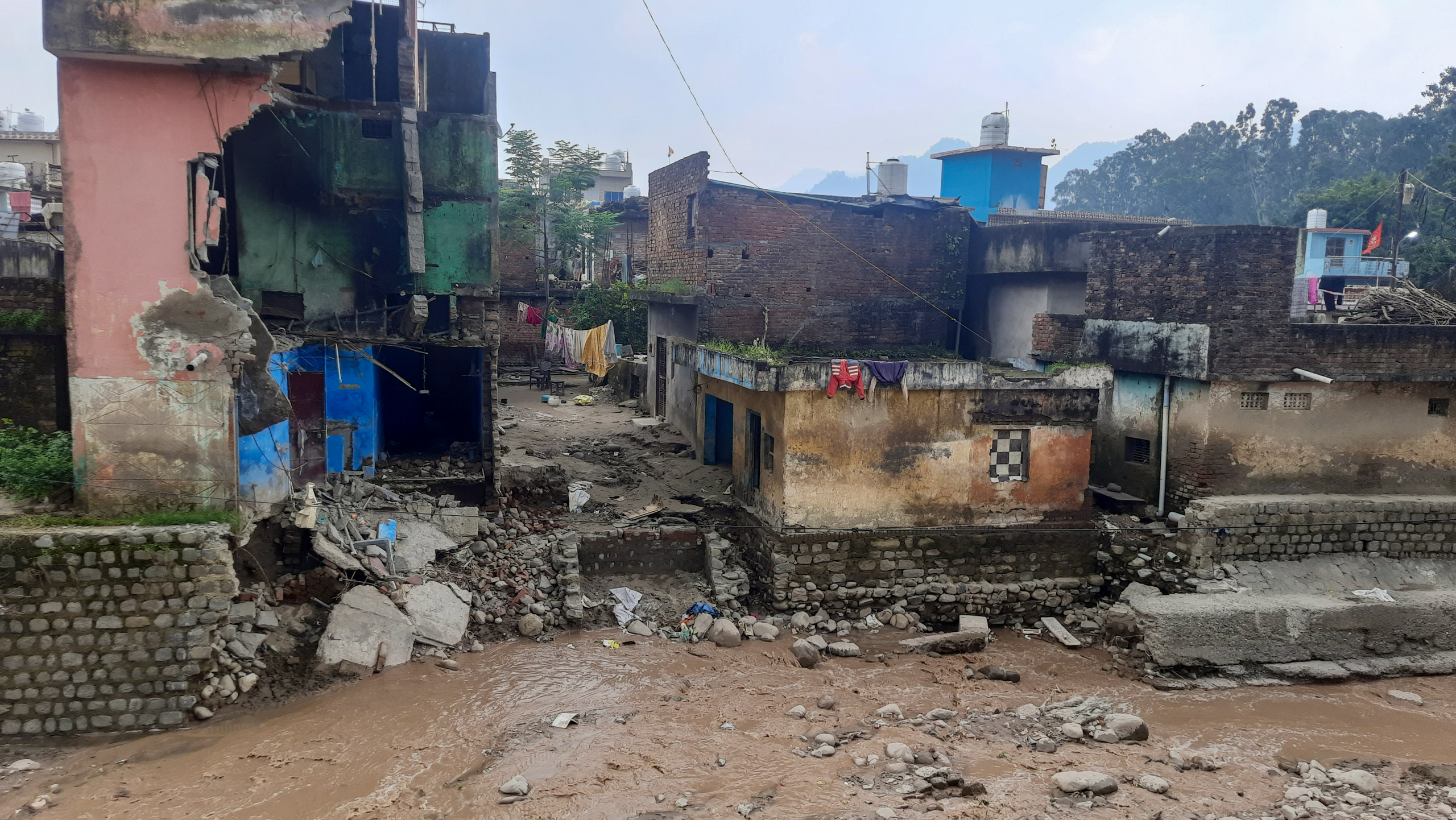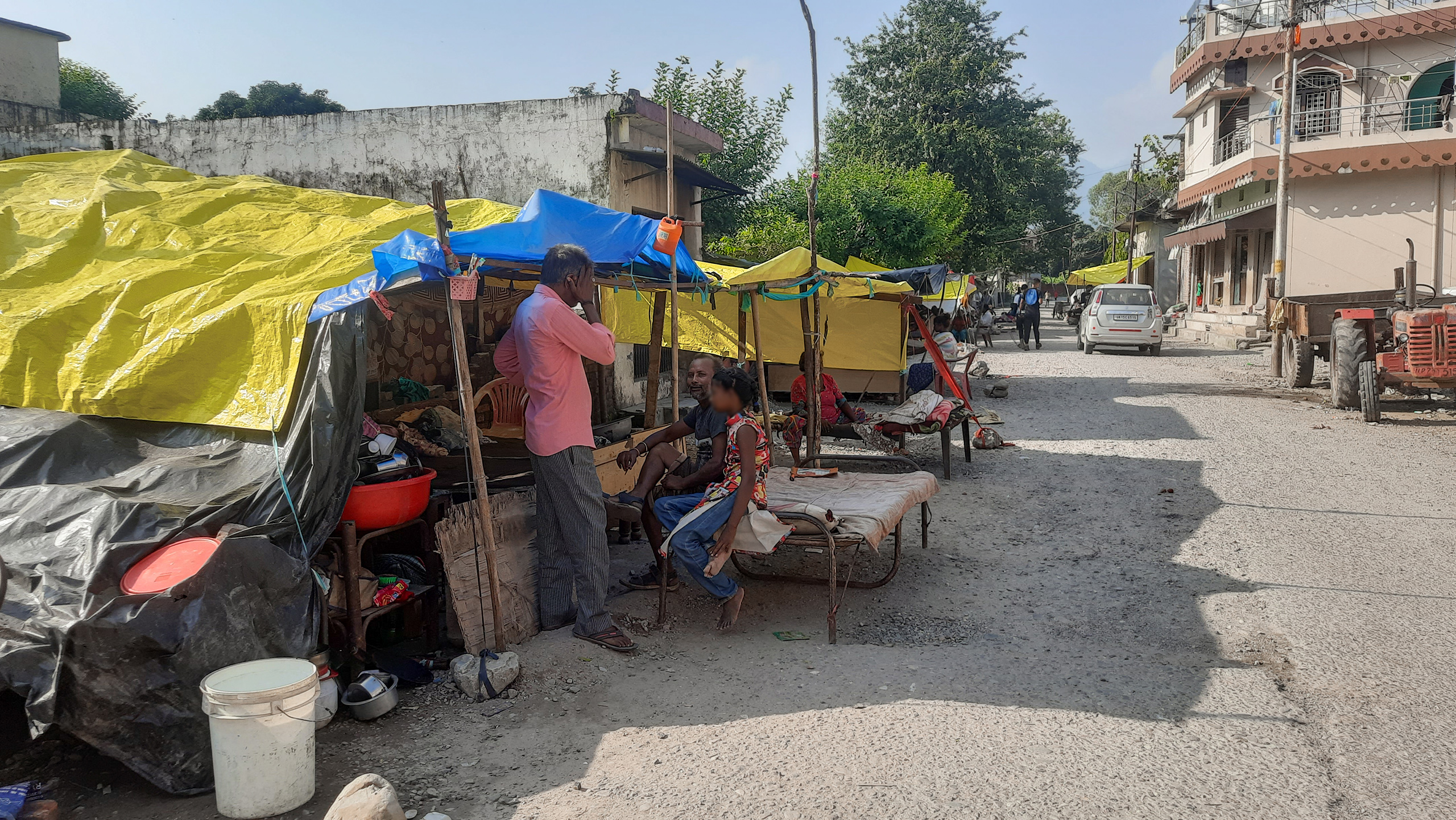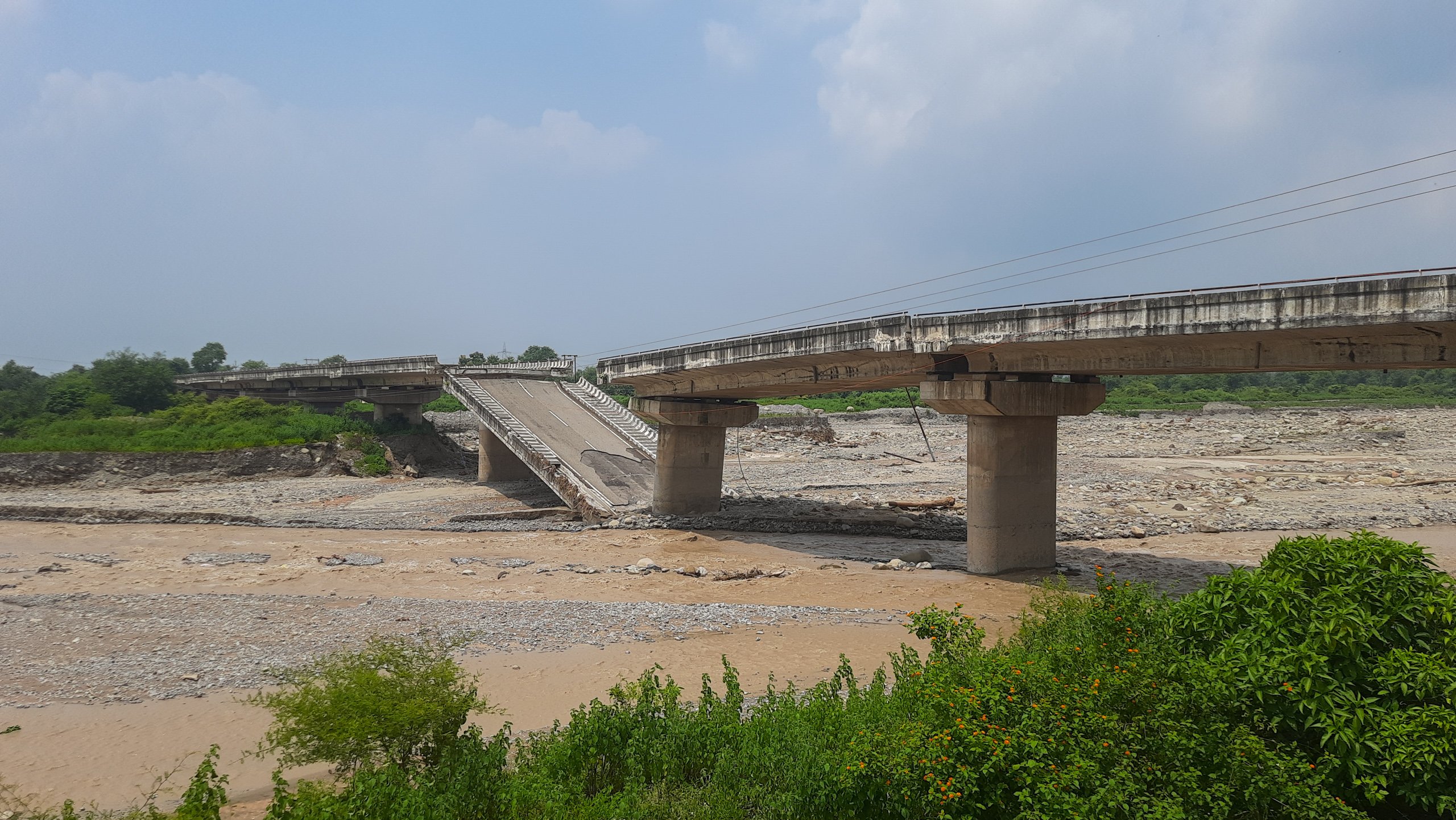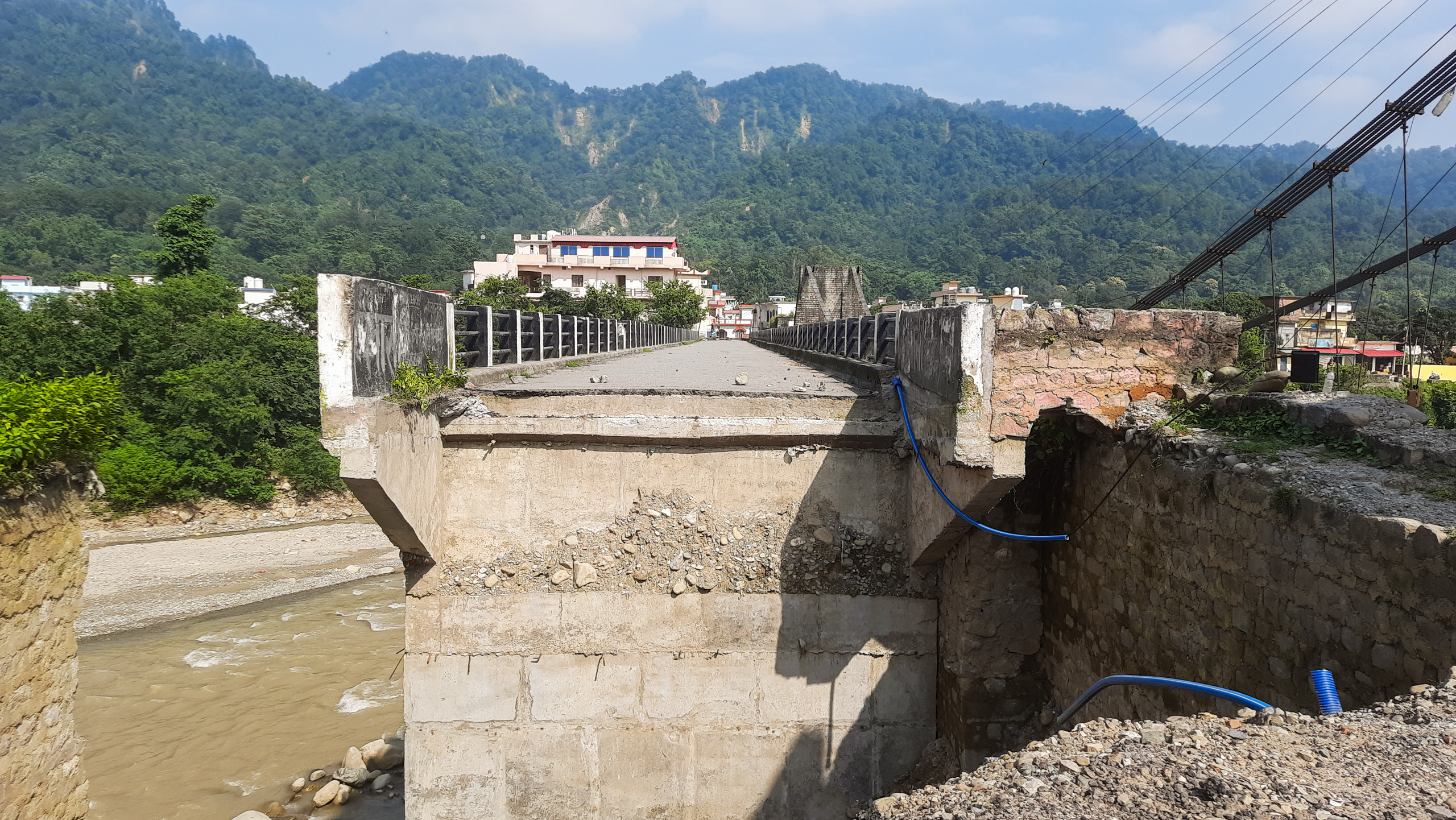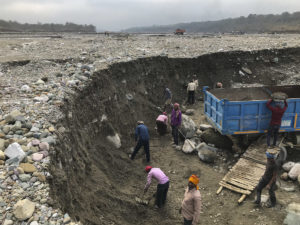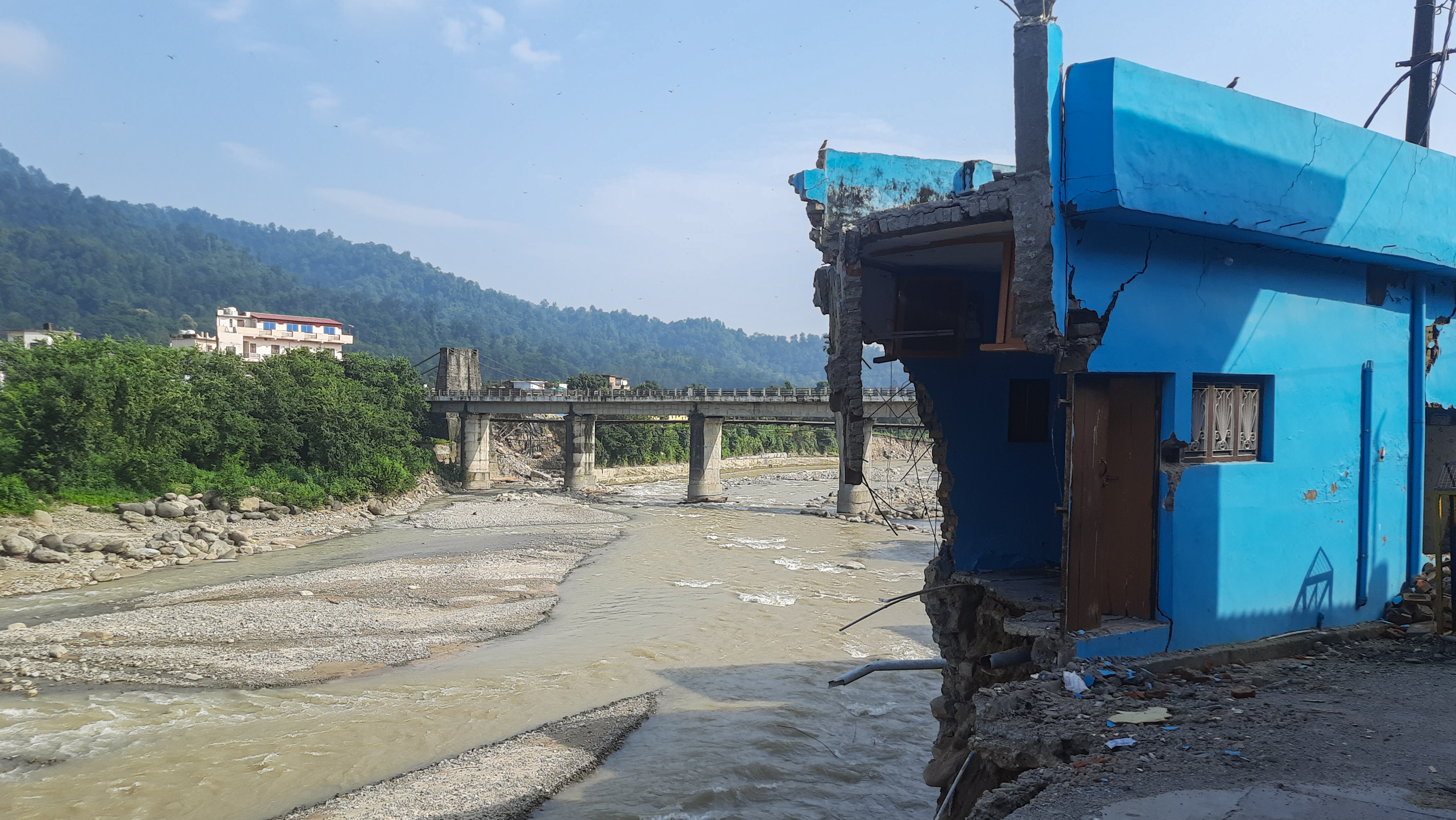
The ruins of one of dozens of houses that were damaged during flooding in Kotdwar, Uttarakhand, on 13 August 2023 (Image: Varsha Singh)
When a spike of rainfall hit the Indian state of Uttarakhand from early July to late August 2023, the town of Kotdwar experienced a series of disasters. Four rivers – the Khoh, Sukhro, Malan and Paniyali – flow through the town. As the rivers flooded, a bridge over the Malan collapsed on 13 July, as did a bridge over the Paniyali on 28 July. Then on 8 August, the approach road to the bridge over the Khoh broke apart. Many houses, small bridges, roads, and security walls were damaged as the rivers surged.
Across the state of Uttarakhand, almost 100 people were killed in disasters between 15 June and 15 September, with 1,100 landslides recorded in the state in 2023 so far – the highest in eight years.
Dharamveer Prajapati, a resident of Kotdwar, stands in front of a house that was half washed away in the floods. “There was a cloudburst on 8 August and again on 13 August. The water moved forward destroying everything that came its way,“ he says, pointing to the Khoh River. “At least 40-45 houses were destroyed. Now, it doesn’t seem as if any house existed here.”
Role of illegal sand mining highlighted
Part of the reason for the significant destruction seen in Kotdwar was the record rainfall which drove the rivers to flood. But Uttarakhand’s rivers have long been plagued by illegal sand mining.
In July, a video went viral in which Ritu Khanduri Bhushan, speaker and representative for Kotdwar in the Uttarakhand Legislative Assembly, criticised a senior state bureaucrat over ignoring the condition of bridges, and went on to mention khanan [mining] in this regard.
The mining of sand and boulders from river beds, mostly for production of cement, has the effect of the deepening the river channel and increasing the speed of water flowing through it. This increased flow can lead to more erosion of river banks, and more damage to structures in floods. In 2012, after a case was heard in India’s Supreme Court against the destructive effects of sand mining in the country’s rivers, the Ministry of Mines framed guidelines for sand mining. Recent reporting reveals that the state of Uttarakhand has lobbied for loosening such restrictions over the last few years, and ignored the rules.
Government agencies […] collectively failed to prevent and detect illegal mining
2022 report by India’s Comptroller and Auditor General
Speaking to The Third Pole, Bhushan says: “We have continuously raised the issue of illegal mining in Kotdwar. Uncontrolled mining was carried out in Malan, Sukhro and River Khoh. Mining should happen in rivers but we have to understand the way we are doing it.”
According to Prajapati, illegal mining takes place in the Khoh in the day and at night. “Due to mining, small and big bridges broke at many places. Bridges on River Sukhro and River Malan were also damaged due to the same reason,” he says.
In August, the Uttarakhand High Court ordered a stop to mining activities in the Malan, Sukhro and Khoh rivers in Kotdwar, while hearing a public interest litigation case regarding bridge breakages due to illegal mining.
Government’s own reports cite problems
A 2015 environmental assessment report on sand mining in the Malan by the Uttarakhand Forest Development Corporation, a state government body, specifically mentioned erosion and floods as outcomes of irregular sand mining in the river basin. While there are supposed to be rules in place pertaining to river dredging and river training, these have been flouted, according to Mujeeb Naithani, a right to information (RTI) activist based in Kotdwar.
Speaking to The Third Pole, he says: “Under the garb of river training, we see illegal mining happening here. In Kotdwar, initially, the banks of the river were weakened by digging. At some places in the river, excavation was done to a depth of 6 metres [when it is only allowed up to 3 metres]. If there was river training, the water would have moved straight ahead and it would have taken a lot of time to [erode] one-fourth of the river banks. But there were no shores left. That is why erosion took place up till houses and other infrastructure.”
Mujeeb shared copies of letters written by the Uttarakhand Irrigation Department in 2020 in which illegal mining is confirmed to be occurring in Kotdwar’s rivers, and the risk of security walls around the river being breached during the rainy season is also noted.
In Uttarakhand, the problem of illegal sand mining is not restricted to Kodtwar. A damning report on illegal sand mining by the Comptroller and Auditor General of India (CAG) was tabled in the Uttarakhand Assembly this year. It states bluntly that, “All Government agencies like Geology and Mining Unit, District Collector, Police Department, Forest Department and Project proponent and Garhwal Mandal Vikas Nigam Ltd. collectively failed to prevent and detect illegal mining.” It added that the government of Uttarakhand had “failed to implement Government of India’s initiative called Mining Surveillance System for over five years,” and that the state government had itself used 3.7 million tonnes of “illegal mined material” in the state capital, Dehradun.
Kulbhushan Upmanyu, an environmentalist and president of civil society organisation Himalaya Niti Abhiyan says: “Illegal sand mining is a major issue, not only in the plains but also in the rivers in the hilly areas of the Himalayan states. We do not see tractors being used in farming in the mountains but tractors keep roaming on the banks of rivers for mining. This has become a lucrative business because there is no investment in [dealing with] it. The government also does not take any strict actions.”
The CAG report tabled in the Uttarakhand Legislative Assembly points out that many fines for illegal activity have simply not been collected. “The [Industrial Development] Department, therefore, suffered revenue loss of INR 1.24 crore due to not imposing the required penalty on illegal mining/storage,” it says.
Sand mining and destructive floods in Himachal Pradesh
The neighbouring state of Himachal Pradesh was even worse hit than Uttarakhand in recent floods. The state government has estimated the damage caused by catastrophic rainfall between 24 June and 31 August 2023 at INR 120 billion (USD 1.44 billion), with more than 360 people killed.
Increased water levels in the Beas River caused floods in Kullu, Mandi, Hamirpur districts in Himachal Pradesh, and downstream in the neighbouring state of Punjab. There have been complaints of illegal mining in the Beas which leading the river to change its course, causing floods. Nearly 12,000 villages in 20 districts across Punjab and 65 lives were lost in the floods. Authorities have largely focused on encroachment on the riverbed as the main reason for the scale of the disaster.
Vikramaditya Singh, minister of public works in the Himachal Pradesh state government, tells The Third Pole: “Along with heavy rains in the state, the condition of the rivers also deteriorated due to illegal mining. This is also an important reason for the suffered loss. The erosion increased because the banks were damaged and the river changed its course. Taking a lesson from these incidents, on August 23, we have stopped all the stone crushers running on Beas and its tributaries. We will also take similar action against crushers operating on other rivers.”
Anil Kumar, an expert in riverine processes, paleo hydrology and sedimentology at the Wadia Institute of Himalayan Geology in Dehradun, Uttarakhand, saw the floods in the Beas River in person in August. He says that floods reached a height of 8-9 metres near Pandoh Dam in Mandi District.
“Due to mining, huge pits are often formed in the riverbed. When suddenly strong waves of water arrive, the flow is obstructed, resulting into an accumulation of energy,” Kumar tells The Third Pole. “At that mining point, the river changes the direction of flow. This is when erosion takes place.”
Kumar says more research is needed into the effects of sand mining on Himalayan rivers. But so far, the problem looks set to continue. In late August in Kodtwar, tractors were still queuing along the broken approach road to the bridge, with boulders brought from the river lying next to them. Mules, used to transport the mined material away, were standing nearby.

